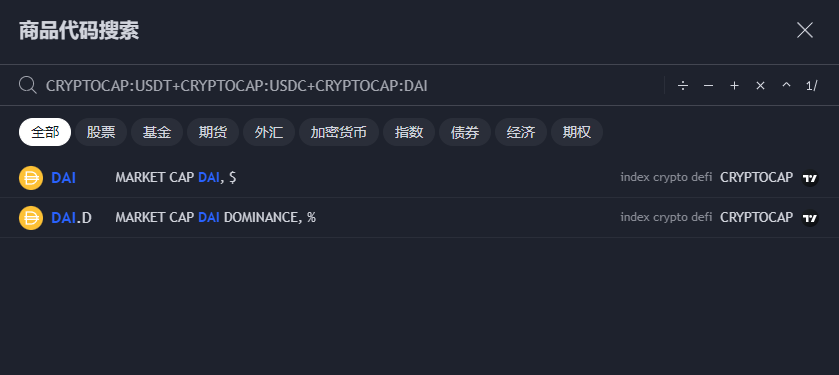
DAI
DAI-pris
$1,0001
+$0
(+0,00 %)
Prisförändring de senaste 24 timmarna

Hur känner du för DAI idag?
Dela dina känslor här genom att göra tummen upp om du känner dig bullish för coin eller tummen ner om du känner dig bearish.
Rösta för att visa resultat
Friskrivningsklausul
Det sociala innehållet på den här sidan ("Innehållet"), inklusive men inte begränsat till tweets och statistik som tillhandahålls av LunarCrush, kommer från tredje part och tillhandahålls " i befintligt skick" och endast i informationssyfte. OKX garanterar inte innehållets kvalitet eller sanningshalt, och innehållet representerar inte OKX:s åsikter. Det är inte avsett att tillhandahålla (i) investeringsrådgivning eller -rekommendationer; (ii) ett erbjudande eller en uppmaning att köpa, sälja eller inneha digitala tillgångar; eller (iii) finansiell, redovisnings-, juridisk eller skatterådgivning. Digitala tillgångar, inklusive stabil kryptovaluta och NFT:er, innebär en hög grad av risk och kan fluktuera kraftigt. Priset och prestandan för den digitala tillgången är inte garanterade och kan ändras utan föregående meddelande.<br>OKX tillhandahåller inga rekommendationer om investeringar eller tillgångar. Du bör noga överväga om handel eller innehav av digitala tillgångar är lämpligt för dig, med tanke på din ekonomiska situation. Vänligen rådfråga en juridisk-/skatte-/investeringsrådgivare för frågor om just dina specifika omständigheter. För mer information, vänligen se våra <a href="/help/terms-of-service">Användarvillkor</a> och <a href="/help/risk-compliance-disclosure">Riskvarning</a>. Genom att använda tredjepartswebbplatsen (”third-party website/TPW”) godkänner du att all användning av TPW kommer att omfattas av och regleras av villkoren i TPW. Om inte annat uttryckligen anges skriftligen är OKX och dess dotterbolag ( OKX ) inte på något sätt associerade med ägaren eller operatören av TPW. Du samtycker till att OKX inte är ansvarigt eller skyldigt för någon förlust, skada eller andra konsekvenser som uppstår på grund av din användning av TPW. Vänligen observera om att användning av en TPW kan resultera i förlust eller minskning av dina tillgångar. Produkten kanske inte är tillgänglig i alla jurisdiktioner.
DAI marknadsinfo
Marknadsvärde
Marknadsvärde beräknas genom att multiplicera det cirkulerande utbudet av ett coin med dess senaste pris.
Börsvärde = Cirkulerande utbud × Senaste pris
Börsvärde = Cirkulerande utbud × Senaste pris
Cirkulerande utbud
Totalt belopp för ett coin som är allmänt tillgängligt på marknaden.
Marknadsvärde-rankning
Ett coins rankning i termer av marknadsvärde.
Högsta någonsin
Högsta pris ett coin har nått i sin handelshistorik.
Lägsta någonsin
Lägsta pris ett coin har nått i sin handelshistorik.
Marknadsvärde
$3,65B
Cirkulerande utbud
3 652 178 029 DAI
100,00 % av
3 652 178 029 DAI
Marknadsvärde-rankning
26
Granskningar

Senaste granskningen: 1 maj 2021
Högsta priset under 24 tim
$1,0022
Lägsta priset under 24 tim
$0,99990
Högsta någonsin
$8 976,00
−99,99 % (-$8 975,00)
Senast uppdaterad: 2 aug. 2019
Lägsta någonsin
$0,0011000
+90 818,18 % (+$0,99900)
Senast uppdaterad: 2 aug. 2019
DAI-flödet
Följande innehåll är hämtat från .

Richard Heart
Kapitalismen frodas av konkurrens. Kryptovaluta trivs med decentralisering. Ett lagförslag som lamslår konkurrensen genom att bestämma vilken kod man kan skriva och vilken kod människor kan köra från sina egna hem är oamerikanskt. Och man måste fråga sig själv, varför skulle vissa människor främja ett lagförslag som hindrar någon från att ge dig gratis mynt? En proposition som förhindrar avkastning... Varför skulle någon konsument föredra att ett megaföretag behåller avkastningen i stället för att ge den till användarna? Förklara. USDC USDT DAI Stablecoin STABIL GENIUS
Visa original10,18 tn
528

OKX Ventures
I april nådde Ethereum On-Chain stablecoin-transaktionsvolymen rekordhöga 908 miljarder dollar
Enligt Techinasia nådde Ethereums on-chain stablecoin-transaktionsvolym en rekordhög nivå på 908 miljarder dollar i april 2025, vilket belyser den växande användningen av stablecoins inom finanssektorn. Bland dem stack USDC ut, med över 500 miljarder dollar i transaktionsvolym under de senaste sex månaderna. Andra stablecoins, som DAI och USDS, visade också stark handelsaktivitet, vilket indikerar en trend mot diversifiering på stablecoin-marknaden.
Stora företag som Meta och Stripe utforskar eller lanserar också stablecoin-baserade betalningslösningar. Trots ökande konkurrens är Ethereum fortfarande den föredragna blockchain-plattformen för stablecoin-applikationer, driven av ihållande transaktionstillväxt och starkt företagsintresse.
Visa original14,26 tn
20

ChainCatcher 链捕手
Enligt Techinasia, i april 2025, nådde handelsvolymen för Ethereums on-chain stablecoin en rekordnivå på 908 miljarder dollar, vilket belyser dess växande popularitet inom finanssektorn. USDC sticker ut i denna tillväxttrend, med mer än 500 miljarder dollar i handelsvolym under de senaste sex månaderna. Andra stablecoins, som DAI och USDS, handlas också aktivt, vilket tyder på att stablecoin-marknaden diversifieras.
Företagsjättar som Meta och Stripe utforskar eller lanserar också för närvarande stablecoin-baserade betalningslösningar. Trots konkurrensen är Ethereum fortfarande den bästa blockkedjeplattformen för stablecoin-applikationer, driven av fortsatt tillväxt i transaktionsvolymer och starkt företagsintresse.
Visa original16,35 tn
0

Crypto_Painter
Sammanfattning av formelberäkningsformler för BTC, stablecoins och likviditetsrelaterade råvarusymboler:
1. StableCoin Marknadsvärde1 (långsiktigt diagram, exklusive USDC)
CRYPTOCAP:USDT+CRYPTOCAP:USDC+CRYPTOCAP:DAI
2. Stablecoin Marknadsandel Stable.D1 (långsiktigt diagram, exklusive USDC)
(CRYPTOCAP:USDT+CRYPTOCAP:USDC+CRYPTOCAP:DAI)/CRYPTOCAP:TOTAL
3. StableCoin Market Cap2 (kortsiktigt diagram, inklusive USDC)
CRYPTOCAP:USDT+CRYPTOCAP:USDC+CRYPTOCAP:DAI+CRYPTOCAP:USDC
4. Stablecoin marknadsandel Stable.D2 (kortsiktigt diagram, inklusive USDC)
(CRYPTOCAP:USDT+CRYPTOCAP:USDC+CRYPTOCAP:DAI+CRYPTOCAP:USDC)/CRYPTOCAP:TOTAL
5. Nettolikviditet i USD
FRED:WALCL-FRED:WDTGAL-FRED:RRPONTTLD
6. Altcoin/BTC Par i marknadsvärde (inklusive ETH)
(CRYPTOCAP:TOTAL2-CRYPTOCAP:USDT)/CRYPTOCAP:BTC
7. Altcoin/BTC Par i marknadsvärde (exklusive ETH)
(CRYPTOCAP:TOTAL2-CRYPTOCAP:USDT-CRYPTOCAP:ETH)/CRYPTOCAP:BTC
8. Marknadsvärdet på kryptovalutor som inte har passerat ETF:en byts ut mot marknadsvärdet på kryptovalutor som har klarat ETF:en
(CRYPTOCAP:TOTAL2-CRYPTOCAP:USDT-CRYPTOCAP:ETH)/(CRYPTOCAP:BTC+CRYPTOCAP:ETH)
9. Växelkurspar för Small Cap Altcoin till BTC
CRYPTOCAP:ANDRA/CRYPTOCAP:BTC
10. BTC/Guldprispar
BITSTAMP:BTCUSD/TVC:GULD
Hur fungerar det?
Kopiera följande symbolformel och klistra in den i symbolfältet i det övre vänstra hörnet av TradingView-diagrammet, som visas i bilden:
Om du vill se fler typer av komplexa produktformler kan du meddela mig i kommentarsfältet, så kommer det att uppdateras i form av trådklistermärken senare!
Ovanstående produktformel är främst för att underlätta för många vänner som inte är bekanta med beräkningen av TV-produkter,Eftersom jag blir tillfrågad av privata meddelanden varje dag,jag gör helt enkelt en sammanfattning för alla på en gång。
Tack för att du läste!
Visa original
68,16 tn
243

definikola
Protokoll #6 - @reflexerfinance
Reflexer är ett utlåningsprotokoll bakom $RAI - ett decentraliserat automatiserat stablecoin utan ett fast inlösenpris (t.ex. $1 som DAI/USDC/USDT), men med ett variabelt inlösenpris, kontrollerat av en PID-kontroller baserad på RAI-marknadspriset.
Visa original4,92 tn
44
DAI prisutveckling i USD
Aktuellt pris på DAI är $1,0001. Under de senaste 24 timmarna har DAI ökade med +0,00 %. Det har för närvarande ett cirkulerande utbud av 3 652 178 029 DAI och ett maximalt utbud av 3 652 178 029 DAI, vilket ger ett marknadsvärde efter full utspädning på $3,65B. För tillfället innehar DAI-coin position 26 i marknadsvärdesrankningar. DAI/USD-priset uppdateras i realtid.
Idag
+$0
+0,00 %
7 dagar
+$0,000100000
+0,00 %
30 dagar
-$0,00040
−0,04 %
3 månader
-$0,00020
−0,02 %
Populära DAI-omvandlingar
Senast uppdaterad: 2025-05-17 19:51
| 1 DAI till USD | 1,0000 $ |
| 1 DAI till EUR | 0,89589 € |
| 1 DAI till PHP | 55,8035 ₱ |
| 1 DAI till IDR | 16 493,49 Rp |
| 1 DAI till GBP | 0,75284 £ |
| 1 DAI till CAD | 1,3971 $ |
| 1 DAI till AED | 3,6730 AED |
| 1 DAI till VND | 25 920,17 ₫ |
Om DAI (DAI)
Betyget som anges är ett sammanställt betyg som inhämtats av OKX från källorna som anges, och det anges endast för informativa syften. OKX garanterar inte betygens kvalitet eller korrekthet. Det är inte avsett att utgöra (i) investeringsrådgivning eller rekommendation, (ii) ett erbjudande eller en uppmaning att köpa, sälja eller inneha digitala tillgångar, eller (iii) finansiell, redovisningsmässig, juridisk eller skattemässig rådgivning. Digitala tillgångar, inklusive stabil kryptovaluta och NFT:er, omfattas av hög risk, kan skifta kraftigt och till och med bli värdelösa. Priset och prestanda för de digitala tillgångarna garanteras inte, och de kan förändras utan föregående meddelande. Dina digitala tillgångar täcks inte av försäkran mot potentiella förluster. Historisk avkastning är ingen garanti om framtida avkastning. OKX garanterar inte någon avkastning, återbetalning av huvudbelopp eller ränta. OKX tillhandahåller inga rekommendationer om investeringar eller tillgångar. Du bör noga överväga om handel med eller innehav av digitala tillgångar är lämpligt för dig med hänsyn till din ekonomiska situation. Rådgör med din jurist, skatteexpert eller investeringsrådgivare om du har frågor om dina specifika omständigheter.
Visa mer
- Officiell webbplats
- Vitbok
- Block explorer
Om tredjeparts webbplatser
Om tredjeparts webbplatser
Genom att använda tredjepartswebbplatsen (”TPW”) samtycker du till att all användning av TPW kommer att omfattas av och styras av villkoren i TPW. Om inte annat uttryckligen anges skriftligen är OKX och dess affiliates (”OKX”) inte på något sätt associerade med ägaren eller operatören av TPW. Du samtycker till att OKX inte är ansvarigt eller skadeståndsskyldigt för förlust, skada eller andra konsekvenser som uppstår till följd av din användning av TPW. Var medveten om att användning av en TPW kan leda till förlust eller minskning av dina tillgångar.
Vanliga frågor för DAI
Hur mycket är 1 DAI värd idag?
För närvarande är en DAI värd $1,0001. För svar och insikt om prisåtgärder för DAI är du på rätt plats. Utforska de senaste diagrammen för DAI och handla ansvarsfullt med OKX.
Vad är kryptovalutor?
Kryptovalutor, till exempel DAI, är digitala tillgångar som fungerar på en offentlig reskontra som kallas blockkedjor. Läs mer om coins och tokens som erbjuds på OKX och deras olika attribut, som inkluderar live-priser och realtidsdiagram.
När uppfanns kryptovalutor?
Tack vare finanskrisen 2008 ökade intresset för decentraliserad finansiering. Bitcoin erbjöd en ny lösning genom att vara en säker digital tillgång på ett decentraliserat nätverk. Sedan dess har många andra tokens som t.ex. DAI skapats också.
Kommer priset på DAI gå upp idag?
Se vår DAI prisprognossida för att förutse framtida priser och fastställa dina prismål.
ESG-upplysning
ESG-regleringar (Environmental, Social och Governance) för kryptotillgångar syftar till att ta itu med eventuell miljöpåverkan (t.ex. energiintensiv mining), främja transparens och säkerställa etiska förvaltningsmetoder för att anpassa kryptoindustrin till bredare hållbarhets- och samhälleliga mål. Dessa regleringar uppmuntrar efterlevnad av standarder som minskar risker och främjar förtroende för digitala tillgångar.
Tillgångsdetaljer
Namn
OKcoin Europe LTD
Relevant juridisk enhetsidentifierare
54930069NLWEIGLHXU42
Namn på kryptotillgången
Dai Token
Konsensusmekanism
Dai Token is present on the following networks: binance_smart_chain, ethereum.
Binance Smart Chain (BSC) uses a hybrid consensus mechanism called Proof of Staked Authority (PoSA), which combines elements of Delegated Proof of Stake (DPoS) and Proof of Authority (PoA). This method ensures fast block times and low fees while maintaining a level of decentralization and security. Core Components 1. Validators (so-called “Cabinet Members”): Validators on BSC are responsible for producing new blocks, validating transactions, and maintaining the network’s security. To become a validator, an entity must stake a significant amount of BNB (Binance Coin). Validators are selected through staking and voting by token holders. There are 21 active validators at any given time, rotating to ensure decentralization and security. 2. Delegators: Token holders who do not wish to run validator nodes can delegate their BNB tokens to validators. This delegation helps validators increase their stake and improves their chances of being selected to produce blocks. Delegators earn a share of the rewards that validators receive, incentivizing broad participation in network security. 3. Candidates: Candidates are nodes that have staked the required amount of BNB and are in the pool waiting to become validators. They are essentially potential validators who are not currently active but can be elected to the validator set through community voting. Candidates play a crucial role in ensuring there is always a sufficient pool of nodes ready to take on validation tasks, thus maintaining network resilience and decentralization. Consensus Process 4. Validator Selection: Validators are chosen based on the amount of BNB staked and votes received from delegators. The more BNB staked and votes received, the higher the chance of being selected to validate transactions and produce new blocks. The selection process involves both the current validators and the pool of candidates, ensuring a dynamic and secure rotation of nodes. 5. Block Production: The selected validators take turns producing blocks in a PoA-like manner, ensuring that blocks are generated quickly and efficiently. Validators validate transactions, add them to new blocks, and broadcast these blocks to the network. 6. Transaction Finality: BSC achieves fast block times of around 3 seconds and quick transaction finality. This is achieved through the efficient PoSA mechanism that allows validators to rapidly reach consensus. Security and Economic Incentives 7. Staking: Validators are required to stake a substantial amount of BNB, which acts as collateral to ensure their honest behavior. This staked amount can be slashed if validators act maliciously. Staking incentivizes validators to act in the network's best interest to avoid losing their staked BNB. 8. Delegation and Rewards: Delegators earn rewards proportional to their stake in validators. This incentivizes them to choose reliable validators and participate in the network’s security. Validators and delegators share transaction fees as rewards, which provides continuous economic incentives to maintain network security and performance. 9. Transaction Fees: BSC employs low transaction fees, paid in BNB, making it cost-effective for users. These fees are collected by validators as part of their rewards, further incentivizing them to validate transactions accurately and efficiently.
The Ethereum network uses a Proof-of-Stake Consensus Mechanism to validate new transactions on the blockchain. Core Components 1. Validators: Validators are responsible for proposing and validating new blocks. To become a validator, a user must deposit (stake) 32 ETH into a smart contract. This stake acts as collateral and can be slashed if the validator behaves dishonestly. 2. Beacon Chain: The Beacon Chain is the backbone of Ethereum 2.0. It coordinates the network of validators and manages the consensus protocol. It is responsible for creating new blocks, organizing validators into committees, and implementing the finality of blocks. Consensus Process 1. Block Proposal: Validators are chosen randomly to propose new blocks. This selection is based on a weighted random function (WRF), where the weight is determined by the amount of ETH staked. 2. Attestation: Validators not proposing a block participate in attestation. They attest to the validity of the proposed block by voting for it. Attestations are then aggregated to form a single proof of the block’s validity. 3. Committees: Validators are organized into committees to streamline the validation process. Each committee is responsible for validating blocks within a specific shard or the Beacon Chain itself. This ensures decentralization and security, as a smaller group of validators can quickly reach consensus. 4. Finality: Ethereum 2.0 uses a mechanism called Casper FFG (Friendly Finality Gadget) to achieve finality. Finality means that a block and its transactions are considered irreversible and confirmed. Validators vote on the finality of blocks, and once a supermajority is reached, the block is finalized. 5. Incentives and Penalties: Validators earn rewards for participating in the network, including proposing blocks and attesting to their validity. Conversely, validators can be penalized (slashed) for malicious behavior, such as double-signing or being offline for extended periods. This ensures honest participation and network security.
Incitamentmekanismer och tillämpliga avgifter
Dai Token is present on the following networks: binance_smart_chain, ethereum.
Binance Smart Chain (BSC) uses the Proof of Staked Authority (PoSA) consensus mechanism to ensure network security and incentivize participation from validators and delegators. Incentive Mechanisms 1. Validators: Staking Rewards: Validators must stake a significant amount of BNB to participate in the consensus process. They earn rewards in the form of transaction fees and block rewards. Selection Process: Validators are selected based on the amount of BNB staked and the votes received from delegators. The more BNB staked and votes received, the higher the chances of being selected to validate transactions and produce new blocks. 2. Delegators: Delegated Staking: Token holders can delegate their BNB to validators. This delegation increases the validator's total stake and improves their chances of being selected to produce blocks. Shared Rewards: Delegators earn a portion of the rewards that validators receive. This incentivizes token holders to participate in the network’s security and decentralization by choosing reliable validators. 3. Candidates: Pool of Potential Validators: Candidates are nodes that have staked the required amount of BNB and are waiting to become active validators. They ensure that there is always a sufficient pool of nodes ready to take on validation tasks, maintaining network resilience. 4. Economic Security: Slashing: Validators can be penalized for malicious behavior or failure to perform their duties. Penalties include slashing a portion of their staked tokens, ensuring that validators act in the best interest of the network. Opportunity Cost: Staking requires validators and delegators to lock up their BNB tokens, providing an economic incentive to act honestly to avoid losing their staked assets. Fees on the Binance Smart Chain 5. Transaction Fees: Low Fees: BSC is known for its low transaction fees compared to other blockchain networks. These fees are paid in BNB and are essential for maintaining network operations and compensating validators. Dynamic Fee Structure: Transaction fees can vary based on network congestion and the complexity of the transactions. However, BSC ensures that fees remain significantly lower than those on the Ethereum mainnet. 6. Block Rewards: Incentivizing Validators: Validators earn block rewards in addition to transaction fees. These rewards are distributed to validators for their role in maintaining the network and processing transactions. 7. Cross-Chain Fees: Interoperability Costs: BSC supports cross-chain compatibility, allowing assets to be transferred between Binance Chain and Binance Smart Chain. These cross-chain operations incur minimal fees, facilitating seamless asset transfers and improving user experience. 8. Smart Contract Fees: Deployment and Execution Costs: Deploying and interacting with smart contracts on BSC involves paying fees based on the computational resources required. These fees are also paid in BNB and are designed to be cost-effective, encouraging developers to build on the BSC platform.
Ethereum, particularly after transitioning to Ethereum 2.0 (Eth2), employs a Proof-of-Stake (PoS) consensus mechanism to secure its network. The incentives for validators and the fee structures play crucial roles in maintaining the security and efficiency of the blockchain. Incentive Mechanisms 1. Staking Rewards: Validator Rewards: Validators are essential to the PoS mechanism. They are responsible for proposing and validating new blocks. To participate, they must stake a minimum of 32 ETH. In return, they earn rewards for their contributions, which are paid out in ETH. These rewards are a combination of newly minted ETH and transaction fees from the blocks they validate. Reward Rate: The reward rate for validators is dynamic and depends on the total amount of ETH staked in the network. The more ETH staked, the lower the individual reward rate, and vice versa. This is designed to balance the network's security and the incentive to participate. 2. Transaction Fees: Base Fee: After the implementation of Ethereum Improvement Proposal (EIP) 1559, the transaction fee model changed to include a base fee that is burned (i.e., removed from circulation). This base fee adjusts dynamically based on network demand, aiming to stabilize transaction fees and reduce volatility. Priority Fee (Tip): Users can also include a priority fee (tip) to incentivize validators to include their transactions more quickly. This fee goes directly to the validators, providing them with an additional incentive to process transactions efficiently. 3. Penalties for Malicious Behavior: Slashing: Validators face penalties (slashing) if they engage in malicious behavior, such as double-signing or validating incorrect information. Slashing results in the loss of a portion of their staked ETH, discouraging bad actors and ensuring that validators act in the network's best interest. Inactivity Penalties: Validators also face penalties for prolonged inactivity. This ensures that validators remain active and engaged in maintaining the network's security and operation. Fees Applicable on the Ethereum Blockchain 1. Gas Fees: Calculation: Gas fees are calculated based on the computational complexity of transactions and smart contract executions. Each operation on the Ethereum Virtual Machine (EVM) has an associated gas cost. Dynamic Adjustment: The base fee introduced by EIP-1559 dynamically adjusts according to network congestion. When demand for block space is high, the base fee increases, and when demand is low, it decreases. 2. Smart Contract Fees: Deployment and Interaction: Deploying a smart contract on Ethereum involves paying gas fees proportional to the contract's complexity and size. Interacting with deployed smart contracts (e.g., executing functions, transferring tokens) also incurs gas fees. Optimizations: Developers are incentivized to optimize their smart contracts to minimize gas usage, making transactions more cost-effective for users. 3. Asset Transfer Fees: Token Transfers: Transferring ERC-20 or other token standards involves gas fees. These fees vary based on the token's contract implementation and the current network demand.
Början av den period som upplysningen avser
2024-04-20
Slutet av den period som upplysningen avser
2025-04-20
Energirapport
Energiförbrukning
38501.82538 (kWh/a)
Energiförbrukningskällor och -metoder
The energy consumption of this asset is aggregated across multiple components:
To determine the energy consumption of a token, the energy consumption of the network(s) binance_smart_chain, ethereum is calculated first. Based on the crypto asset's gas consumption per network, the share of the total consumption of the respective network that is assigned to this asset is defined. When calculating the energy consumption, we used - if available - the Functionally Fungible Group Digital Token Identifier (FFG DTI) to determine all implementations of the asset of question in scope and we update the mappings regulary, based on data of the Digital Token Identifier Foundation.













Sociala medier